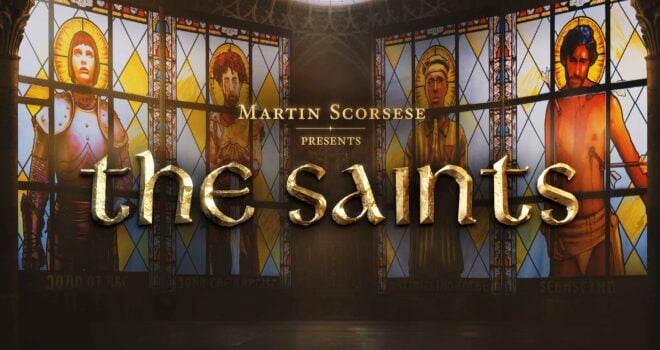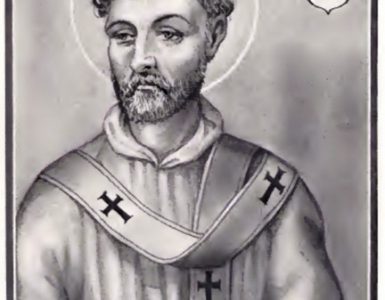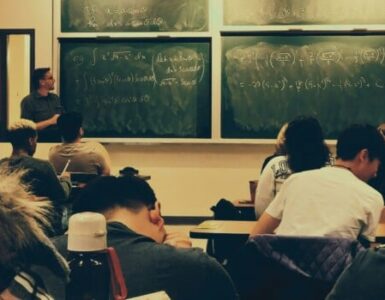There is nothing more fascinating and frightening than the saints—fascinating because of the extraordinary valor and virtue of their lives; frightening because they can seem so other from us in their often-unimaginable holiness.
This fascination and fear come forth in the new and highly anticipated docuseries streaming exclusively on FOX Nation led by the legendary Martin Scorsese. In his words, this limited series will present the “remarkable stories of eight men and women who risked everything to embody humanity’s most noble and complex trait—faith.”
Martin Scorsese Presents: The Saints features cinematic enactments, interspersed with historical documentary-style narration, of the lives of Joan of Arc, John the Baptist, Maximilian Kolbe, Sebastian, Francis of Assisi, Thomas Becket, Mary Magdalene, and Moses the Black. If the two episodes reviewed by this author are any indication, this series will play out with all the reverent wrestling of Mr. Scorsese’s relationship with Catholicism.
It is unusual to find high-quality film material centered on the saints. This series, executively produced and narrated by Martin Scorsese, is different. The quality is clearly high, with striking costumery, dramatic sets, powerful direction, and other excellent production values. But it fails where so many films fail these days: the writing. The scripts are thin and clunky, negatively affecting the acting as bad writing inevitably does.
It is a shame to see beautiful cinematography and noble subject matter dragged down by ham-fisted efforts to capture complex lives, dramatic situations, and spiritual paradox and transcendence in such short and the ultimately restricting space of a 45-minute slot.
That said, it is intriguing to see such efforts exerted over the largely ignored heroism of the saints. There is an authenticity present that rings with a mysterious reality that is refreshing to see in a sacred story on a screen. By all appearances, Mr. Scorsese had a true and genuine interest in exploring these narratives not only with creative care and scholarly critique, but also with deep admiration.
In an interview about the series, Mr. Scorsese recalled his own Catholic upbringing in and out of Old St. Patrick’s Cathedral in New York City, saying,
…what was fascinating to me was certainly the statues of these people, the men and the women. And somehow the stories that these statues implied or suggested, whether it was a statue of Santa Lucia, with the eyes on the plate that she had, or Saint Rocco with his finger pointing to his wound on his leg and a little dog at his feet…
From his youth, Mr. Scorsese was, and still is, on a kind of quest through mean streets for truth, especially religious truth. Once hoping to be a priest himself, entering a minor seminary in New York before turning to a film career, Scorsese is a man and an artist seeking God with a questioning spirit in a troubled world. He has been searching for an age of innocence among taxi drivers, raging bulls, and good fellas for decades.
His notable film, and perhaps his masterpiece, The Departed is engaged and even engrossed with the precarious and puzzling interplay of good and evil in a morally muddied world, as though desperately trying to glimpse God in a sea of devilry. Of course, his film Silence, based on Shusaku Endo’s challenging novel about Jesuit missionaries in 17th century Japan, is a monument to his ardent and arduous search for religious truth—and perhaps, again, drawing a conclusion of ambiguity.
Scorsese went on in his interview to say that, in these days, “many people are trying to find religion outside of religion.” In this keen observation, Scorsese and The Saints seem to get in their own way. That is, there is a quiet yet intense contradiction at work in the source material and their presentation. This incongruity is signaled by the respect these saints are clearly given, and the oddly graphic aspects of the films, which are unnecessarily and distastefully edgy involving female virginity, male nudity, and bloody violence.
This discordance is evocative of a relativist philosophy that fascinates (and probably frightens) Martin Scorsese. While this theme may not be consistent throughout all the episodes (they haven’t all been released yet), the episodes presenting Joan of Arc and Maximilian Kolbe, seem bent upon presenting these saints as outsiders—Catholics that broke the mold of what it meant to be Catholic in some way.
For Joan, it was her mysterious military calling and her insistence upon wearing men’s clothing. She is also portrayed as aggressive and dour, despite her heavenly mysticism which is treated seriously. For Kolbe, it was his compassion for the Jewish people under the Nazi occupation at a time when anti-Zionist, antisemitic sentiment among Catholics was the norm. He is also presented as rather fanatical, despite his pastoral goodness and his incredibly brave sacrifice at Auschwitz.
There is plenty of room given to the fact that saints were human, made mistakes, committed sins, had conversions, and were often controversial. But the controversy of these two saints in particular is presented as one that bucks the trends of the faithful in their times, breaking out of an “accepted” Catholicism. They are shown as going beyond tradition and teaching by reacting to the raw, spiritual experience of real people and real situations.
These saints are purposefully presented as individuals who didn’t think by categories or custom, and in this depiction, the filmmakers betray a desire or instinct to view Catholicism in relative terms as opposed to doctrinal terms, and these films are invitations to think outside the old and established boundaries of the Catholic Church.
Suspicion of this slant becomes even more pointed with the closing feature of each episode: which is, interestingly, a short conversation about the saint with Martin Scorsese, a priest, a poet, and a scholar. But that priest is none other than Fr. James Martin, whose liberal positions and pushings regarding homosexual acceptance within the Church have made him all but anathema in many Catholic circles. Scorsese is good friends with Fr. Martin and collaborated with him in making Silence and his Netflix film, The Irishman.
While it is, admittedly, refreshing to hear Fr. Martin speak with relative clarity and accuracy about the saints and the spiritual life in the concluding segments, it is also difficult to miss the leanings toward an unorthodox openness regarding the Catholic life—and, what is somewhat disturbing, how these saints may have modeled such leanings themselves.
In this friendship with Fr. Martin, Scorsese’s passion to pin down religious truth—or to find religion outside religion—must certainly be engaged, whether in art or his own life, whether by fascination or fear. Or by force. For those unfamiliar with the violent struggle of faith in many of Scorsese’s films, be wary of his religious films (The Last Temptation of Christ is basically blasphemous).
As an artist, Scorsese grapples at God with a robustness that can be reckless and can provoke the demand some desire to make for divine approval for their sufferings—manifestations beyond the revelation of Scripture and the Cross.
There is something in the religious symbology of Scorsese’s work that suggests that Christianity is incompatible with happiness. Scorsese considers himself something of a Catholic, but his vision of the Faith is unhappily impaired, blinded by the visceral and virulent qualities of the human condition.
And this struggle comes through in the tone and tenor of these episodes, rigorous and respectful though they are. There is the speck of something that wants to push the Catholic Faith beyond its established boundaries—and to use the stories of the saints to propose and encourage that motion. It is as though they are trying to find religion outside of religion, to use Scorsese’s words.
Scorsese admires the saints for the risks they took to live out their Faith with kindness and courage—and as an artist, Scorsese admires risk-taking. He admires the dangerous intersection of fascination and fear: which may be called faith. But the risk of walking on the edges of Catholicism in order to, perhaps, discover some new, neglected path that leads to human fulfillment and eternal salvation is not a risk worth taking. There is plenty of risk in holding fast to the truths the Faith has enshrined in the face of a society that rejects objective truth.
Martin Scorsese Presents: The Saints may be a unique treatment of holy history in modern media, but it is still tainted by the unholy liberation-urge that plagues many Catholics who are in the world and, sadly, of the world as well. It is good to see such authenticity and artistic integrity in presenting the lives of saints; but even here, something problematic lurks beneath the surface. While Catholics would do well to engage with this series, their guard should be up, as it is both fascinating and fearful.
Image from Fox Nation












